Like most people, you probably think of guinea pig as cute little pets. But did you know that guinea pigs are considered a delicacy in some parts of the world? That's right - guinea pigs are commonly eaten as part of the traditional cuisine in Peru.
Peruvian cuisine is renowned for its use of fresh, locally sourced ingredients. And guinea pigs are no exception. These furry little creatures are typically raised in small villages, where they're considered a valuable food source.
So what do guinea pigs taste like? Well, they're often compared to chicken or pork. They have a mild flavor and a slightly gamey taste. And when appropriately prepared, they can be pretty delicious!
Best Guinea Pig Recipes - Peruvian Cuisine
What is a guinea pig?
The Guinea Pigs or Cuy (Cavia porcellus) are native rodents to the South American region. Although guinea pigs' names are common, they are unrelated to pigs or from Guinea.
They originated in the Andes Mountains of South America. Studies on biochemistry and hybridization have shown guinea pigs are domesticated animals and do not exist naturally in the wild.
Guinea pigs or Cuyes were initially domesticated in South America as livestock for sources of meat. They were introduced to the Western hemisphere in the 16th century. They are popular pets in North America and Europe thanks to their docile nature and easy handling.
Traditionally, the guinea pig or cuy was reserved only for birthdays, anniversaries, and weddings. However, in recent years, with the development of tourism in rural areas, this delicacy has become available for travelers to try at every tourist restaurant.
Guinea pigs are not everyday food; we have guinea pigs only on select dates, the local Peruvians. My mom still prepares a guinea pig on a stick for every birthday when I visit her after a long time. The meat is high in protein, low in fat and cholesterol, and is similar to rabbit or chicken meat.
Guinea pig or Cuy in Peru
Peruvians do not treat guinea pigs as pets; this is a preferred dish at special events. We even have the National Day of Cuy, celebrated on the second Friday of October every year. The consumption of the animal comes from long ago; it was domesticated around 5000 BC. During the Inca Empire period, it became so popular that it was even documented in the painting of "The Last Supper" on the most famous church in the main square of Cusco, where the apostles are snacking on it.
Guinea pig or cuy is a typical dish in Peru, but it can be found in other South American countries (Ecuador, Colombia, and Bolivia). They are bred by the Andes' people in their house, usually in the kitchen, where they sick the warmth of the Qonchas or wood-fired stoves made of clay and straw.
There are many ways to prepare the guinea pig in Peru, depending on the region you visit, and there will be a typical way to prepare it. Among the most classic dishes, we have Cuy al Horno (Baked Guinea pig), Cuy Chactado (Deep fried guinea pig), Cuy al Palo (Guinea pig on a stick), and Pepian de Cuy (Guinea pig stew). I have seen pictures sent by my guests that they found "cuy nuggets" in North America and Europe, but I have never tried that.
Which guinea pig breeds can be eaten?
Not all guinea pig breeds are meant to be eaten. Only those raised on specialized farms are suitable for human consumption. Some breeds, like the Andean and Inka guinea pigs, are specifically bred for this purpose. If you're thinking about trying your hand at cooking guinea pig, keep in mind that it's something you can only really do in Peru or by sourcing the meat from a specialized farm.
Guinea pig recipes
Peru has around 17 million Cuyes (guinea pigs) spread worldwide; the region that produces more is Cajamarca, followed by Cusco and other areas in the Andes.
Cusco and Arequipa are the most popular regions in consumption, mainly thanks to tourism. While Cusco is famous for the baked guinea pig, Arequipa is renowned for the deep-fried guinea pig.
Find below the most popular guinea pig recipes:
Cuy al Horno
Cuy al Horno (Baked Guinea Pig) is one of the best guinea pig recipes, and it is a traditional Peruvian dish. This recipe calls for the guinea pig to be roasted in an oven, and it is often served with potatoes and a side of salad. Cuy al horno is a simple dish full of flavor and is sure to please even the pickiest of eaters. This recipe is worth trying if you are looking for a new and exciting way to prepare a guinea pig. Although you will find it in almost every tourist restaurant in the country, remember that the fresh guinea pigs are in Cusco.
Ingredients:
- One guinea pig (cuy)
- Huacatay (black mint)
- Three pieces of garlic
- Oil
- Salt
- Pepper
- Cumin
- 6 potatoes
- 1 onion
- 2 tomatoes
- Cilantro
- 2 lemons
- Chili Rellenos (optional on the side)
- Tallarin al horno (Oven Baked Fettuccine) Optional on the side
Preparation:
- Cuy: De-hair the cuy in hot water, gut, and clean it properly; you can use a tweezer to remove the remaining hair, then pat it dry.
- Seasoning: In a separate bowl, mix the garlic, pepper, salt, cumin, oil, and Huacatay (also known as muster wild marigold or black mint). Depending on your location, the last ingredient might not be available, but if you are in Peru, you can find it at any local market. It gives the cuy a unique taste.
- Marination: Cover the whole body of the guinea pig in and out with the prepared seasoning. Then, leave it for some time to marinate (recommended at least 1 hour)
- Baked potatoes: Wash the potatoes properly and add salt when they are still wet, then leave them to dry.
- Bake all together: Place the cuy and the potatoes in a pan and put them in the oven for 1 hour. You can use butter on the pan to have a crunchy experience.
- Sauce: Slice onions and wash them; slice tomatoes, add the cilantro, salt, and lemon, and mix it to taste.
- You can serve the guinea pig with baked potatoes and salsa and add chili Rellenos or/and baked fettuccini. It's important to know that we usually have a whole guinea pig just for one person. Still, we share among three or four and accompany many side dishes like potatoes, chili, or even tortillas.
Cuy Chactado
The guinea pig is coated in seasoned flour and deep-fried in vegetable oil until it becomes crunchy; in some restaurants, the chefs will use a big stone to deepen the pan so the guinea pig can easily break up. The deep-fried guinea pig is then served with potatoes and salad. Cuy Chactado is called the Arequipa region style, where guinea pig is mixed with spices and then fried. The result is a juicy, flavorful, and truly unique meal you won't find anywhere else.
Ingredients:
- 1 Guinea pig
- 1/2 kg of flour (1.1 lb)
- Salt
- Pepper
- Cumin
- Oil
- Cilantro
- Potatoes
- 1 onion
- 2 tomatoes
- 2 lemons
Preparation:
- Cuy: Depilate the guinea pig using hot water, remove the internal organs, wash them, then pat them dry.
- Seasoning: Mix the pepper, salt, cumin, and oil, and rub the guinea pig in and out. Then cover the guinea pig in flour and put it in hot oil until crispy (it takes about 10 minutes).
- Potatoes: You can add baked potatoes or fried slices.
- Sauce: Slice the onions and rinse them thoroughly. Slice the tomatoes, then add chopped cilantro and freshly squeezed lemon juice. Mix everything together and add salt to taste.
- Serve the guinea pig with potatoes, salsa, and other side dishes you like.
Cuy al Palo
Cuy al Palo, or Guinea pig on a stick, is typical in Peru, and it's the most common way the locals prepare. The villagers do not have access to an oven in the countryside, so the best way to prepare is to roast in front of their "Qonchas," or wood-fired stoves. This style can be seen in the Sacred Valley and is available for travelers.
Ingredients:
- 1 guinea pig (cuy)
- Huacatay (black mint)
- 2 pieces of garlic
- Oil
- Salt
- Pepper
- Cumin
- 6 potatoes
- 1 onion
- 2 tomatoes
- Cilantro
- 2 lemons
- 1 piece of wood to use as a stick (washed and cleaned)
- Chili Rellenos (optional on the side)
- Tallarin al Horno (Oven Baked Fettuccine) Optional on the side
Preparation:
- Cuy: Use hot water to remove hair from the cuy, then clean the internal organs properly. Use tweezers to remove the remaining hair and then pat it dry.
- Seasoning: Mix garlic, pepper, salt, cumin, oil, and Huacatay (also known as "John Henry," Southern Marigold, or Black Mint) separately. Depending on your location, you may not find the last ingredient, but if you are in Peru, you can find it in any local market; this ingredient gives a unique taste to the cuy.
- Marination: Cover the entire guinea pig with the prepared seasoning from inside to outside. Then, please leave it to marinate for some time (at least 1 hour is recommended)
- Baked Potatoes: Wash the potatoes properly, add salt when it is still wet, and then leave them to dry. Then, it would be best if you baked the potatoes or you could get deep in oil.
- Roast the guinea pig: Skewer the cuy and grill on the fire; you must turn the stick repeatedly until it is crispy and ready.
- Sauce: Wash the tomatoes and onions and cut them into slices; add coriander and lemon, and mix to taste with salt.
- You can serve the guinea pig with baked potatoes, salsa, chili Rellenos, or/and baked fettuccini. It's important to know that we usually don't give a whole guinea pig to one person, but we have to share it and add side dishes such as potatoes, peppers, and even tortillas.
Pepian de Cuy
Pepián de cuy is a hearty stew made with guinea pig meat and corn seasoned with peppers, onions, and peanuts.
Ingredients:
- 1 guinea pig
- 2 yellow potatoes
- 1/2 kg of rice (1.1 lb)
- 1 onion
- Roasted peanuts
- Oil, salt, pepper, and garlic, to taste
Preparation:
Cut the guinea pig into four pieces, fry it lightly, then bring it to a pot with corn, onion, garlic, pepper, and salt. Before removing it from the fire, add roasted and ground peanuts to give it a pleasant flavor. It is served with rice.
Pachamanca
Pachamanca is a traditional way of cooking meat, vegetables, and fruits, we use hot stones, and all the ingredients are buried underground. This style has existed for centuries and is very popular in Andean communities. Due to its difficulty, this dish is prepared only for big celebrations and select dates.
At TreXperience, our chefs will prepare Pachamanca in every alternative trek of 3 days or more. We do not design this dish due to fire restrictions during the Inca Trail.
The first step for Pachamanca is to create a small stone oven with a rock. To make this, first, you must gather the stones, wash them, prepare a circle on the ground, and carefully build the oven.
Once the oven is ready, you must start heating the rocks in the oven with a constant fire; the approximate time is about 3 hours until the rock becomes white.
Once the rocks are hot enough, you must place all ingredients between them and bury them with enough soil that no air must come out. This will allow the meat to cook quickly and keep its moisture. The cooking will take around 45 minutes.
Once the Pachamanca is ready, remove the soil on top with a shovel and carefully remove the meat and vegetable, and you can serve.
Ingredients:
- Meat: You must marinate the meat; one day before is better with spices depending on your desired meat. You can place guinea pig, alpaca, beef, lamb, fish, chicken, duck, turkey, etc. Also, you can put cheese in a pot.
- Vegetables: Beans, potatoes, sweet potatoes, fresh corn
- Fruits: Bananas, pineapple
When it is time to open the oven, all the family will gather to taste the meat; the cuy has a unique flavor when cooked in a Pachamanca. You can serve the Pachamanca with preferred sauces.
Craving more delicious Peruvian flavors? Take a look at these articles:

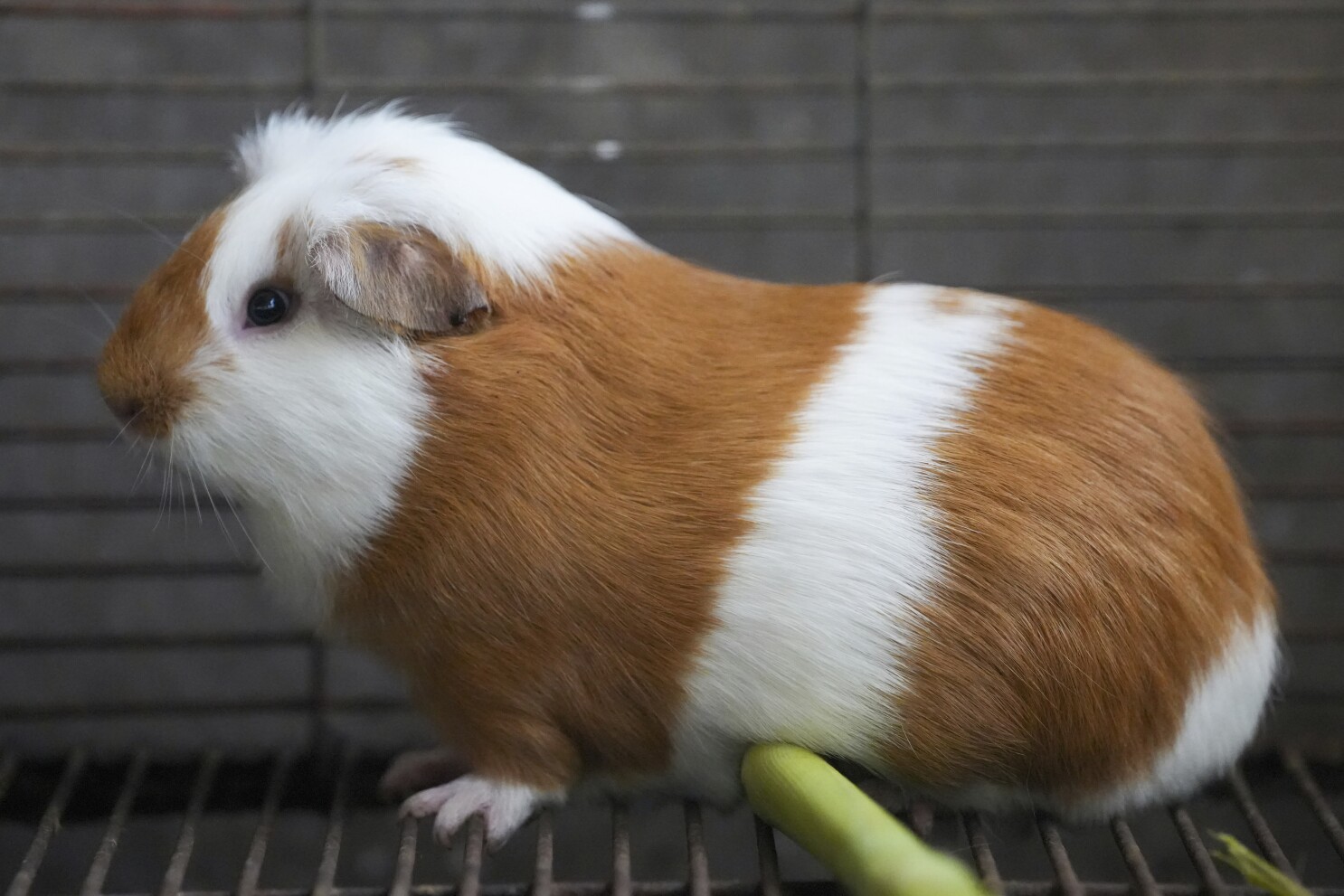

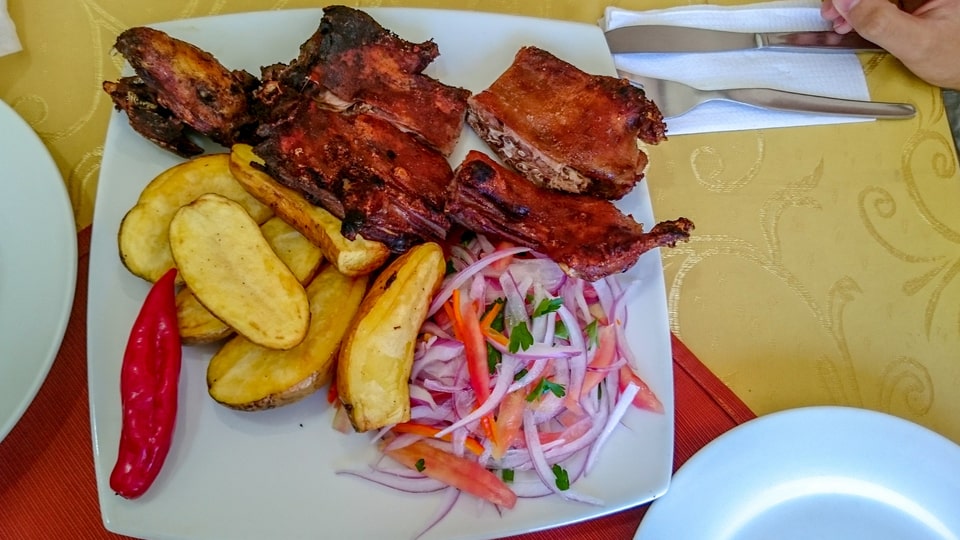
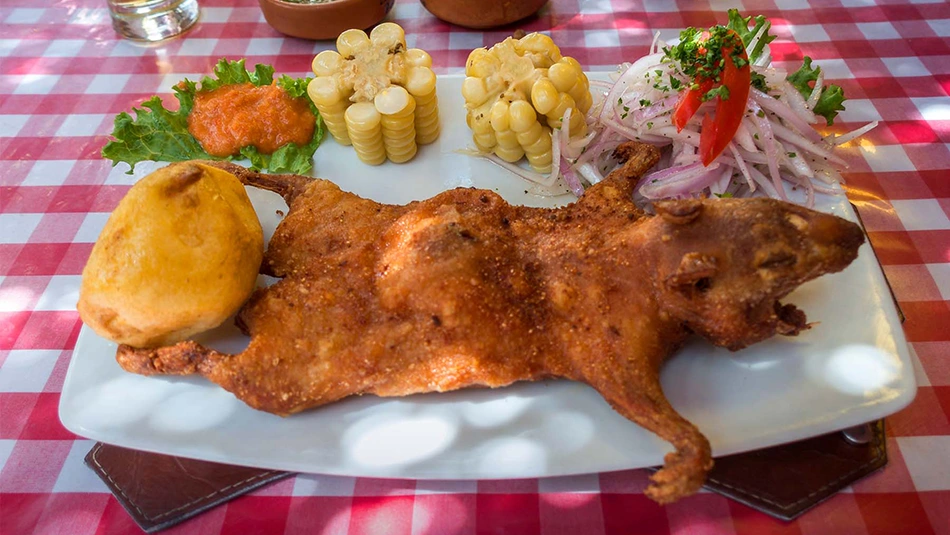
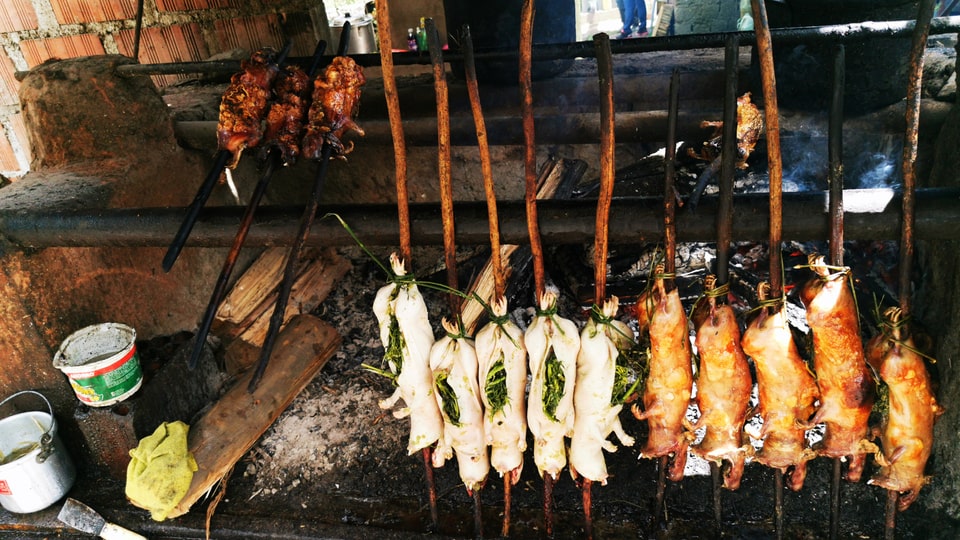
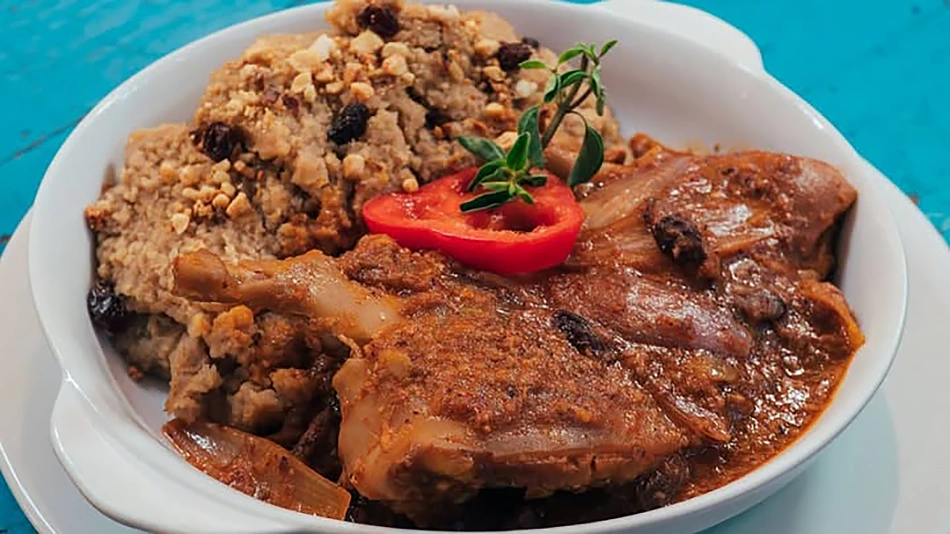
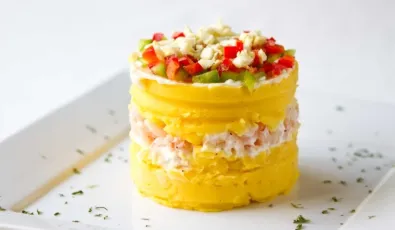
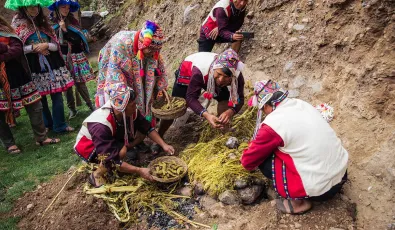
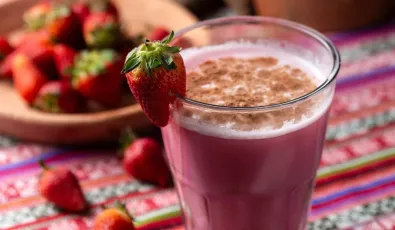

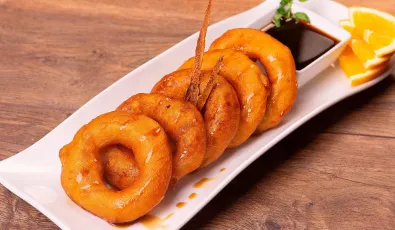

online
Howdy! This post could not be written any better! Reading through this post reminds me of my good old room mate! He always kept talking about this. I will forward this post to him. Pretty sure he will have a good read. Thanks for sharing!
guinea pig
it makes me so sad to see these little guys eaten when i have 4 and they are the best pets ever.
Yum
tasty
guinea pig
I can still see it's little face
yeah okay
let me find out what parts your guinea pigs stay at there gonna be a part of my diet
yeah okay
i just love eating these cute little guys i buy one from a pet store and look at them just to remind me how good they taste
Note on pet guinea pigs
Hello. Just a quick note — the guinea pigs sold in pet stores are not intended for human consumption. We don’t promote the consumption of any type of guinea pig that isn’t raised on specialized farms for that purpose.
yum yum yum
so so so yummy i can’t believe how good this was and my mouth is watering thinking about the next time i eat one
Bugs
Eat Guinea pigs
cuy
I love cuy
Thank you for the recipes!
Thank you for the recipes!
yum yum chicken
This was so sigma
Guinea Pig Friends
I was just looking in the pet store, at some other pet. I happened to notice the guinea pigs at a steep discount.
Honestly they are cheaper than beef at the price.
I bought several. The best part is that I don't need to freeze them and their food is very cheap. The night before I will prepare them to marinade. Cooking is easy at this time of year!
Pet guinea pigs
Hi! Just a quick note — the guinea pigs sold in pet stores are not intended for human consumption. We don’t promote the consumption of any type of guinea pig that isn’t raised on specialized farms for that purpose.
you cant eat the one at pet…
you cant eat the one at pet stores those are house pets they are not the same farm bred guinea pigs
your gonna get a new type of dieasse lmao 🙏
Add new comment